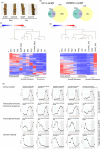CRISPR-Cas9-mediated mutagenesis of kiwifruit BFT genes results in an evergrowing but not early flowering phenotype
- PMID: 35796629
- PMCID: PMC9616528
- DOI: 10.1111/pbi.13888
CRISPR-Cas9-mediated mutagenesis of kiwifruit BFT genes results in an evergrowing but not early flowering phenotype
Abstract
Phosphatidylethanolamine-binding protein (PEBP) genes regulate flowering and architecture in many plant species. Here, we study kiwifruit (Actinidia chinensis, Ac) PEBP genes with homology to BROTHER OF FT AND TFL1 (BFT). CRISPR-Cas9 was used to target AcBFT genes in wild-type and fast-flowering kiwifruit backgrounds. The editing construct was designed to preferentially target AcBFT2, whose expression is elevated in dormant buds. Acbft lines displayed an evergrowing phenotype and increased branching, while control plants established winter dormancy. The evergrowing phenotype, encompassing delayed budset and advanced budbreak after defoliation, was identified in multiple independent lines with edits in both alleles of AcBFT2. RNA-seq analyses conducted using buds from gene-edited and control lines indicated that Acbft evergrowing plants had a transcriptome similar to that of actively growing wild-type plants, rather than dormant controls. Mutations in both alleles of AcBFT2 did not promote flowering in wild-type or affect flowering time, morphology and fertility in fast-flowering transgenic kiwifruit. In summary, editing of AcBFT2 has the potential to reduce plant dormancy with no adverse effect on flowering, giving rise to cultivars better suited for a changing climate.
Keywords: Actinidia chinensis; BFT; CRISPR-Cas9; dormancy; flowering; kiwifruit.
© 2022 The New Zealand Institute for Plant and Food Research Ltd and The Authors. Plant Biotechnology Journal published by Society for Experimental Biology and The Association of Applied Biologists and John Wiley & Sons Ltd.
Conflict of interest statement
The authors declare no conflict of interest.
Figures





Similar articles
-
Three FT and multiple CEN and BFT genes regulate maturity, flowering, and vegetative phenology in kiwifruit.J Exp Bot. 2017 Mar 1;68(7):1539-1553. doi: 10.1093/jxb/erx044. J Exp Bot. 2017. PMID: 28369532 Free PMC article.
-
Homologs of FT, CEN and FD respond to developmental and environmental signals affecting growth and flowering in the perennial vine kiwifruit.New Phytol. 2013 May;198(3):732-746. doi: 10.1111/nph.12162. Epub 2013 Mar 6. New Phytol. 2013. PMID: 23577598
-
Functional and expression analyses of kiwifruit SOC1-like genes suggest that they may not have a role in the transition to flowering but may affect the duration of dormancy.J Exp Bot. 2015 Aug;66(15):4699-710. doi: 10.1093/jxb/erv234. Epub 2015 May 15. J Exp Bot. 2015. PMID: 25979999 Free PMC article.
-
A MADS-box gene with similarity to FLC is induced by cold and correlated with epigenetic changes to control budbreak in kiwifruit.New Phytol. 2022 Mar;233(5):2111-2126. doi: 10.1111/nph.17916. Epub 2022 Jan 4. New Phytol. 2022. PMID: 34907541
-
Evolution and functional diversification of FLOWERING LOCUS T/TERMINAL FLOWER 1 family genes in plants.Semin Cell Dev Biol. 2021 Jan;109:20-30. doi: 10.1016/j.semcdb.2020.05.007. Epub 2020 Jun 2. Semin Cell Dev Biol. 2021. PMID: 32507412 Review.
Cited by
-
Advancing tree genomics to future proof next generation orchard production.Front Plant Sci. 2024 Jan 19;14:1321555. doi: 10.3389/fpls.2023.1321555. eCollection 2023. Front Plant Sci. 2024. PMID: 38312357 Free PMC article. Review.
-
Kiwifruit in the Omics Age: Advances in Genomics, Breeding, and Beyond.Plants (Basel). 2024 Aug 3;13(15):2156. doi: 10.3390/plants13152156. Plants (Basel). 2024. PMID: 39124274 Free PMC article. Review.
-
Taming the wild: domesticating untapped northern fruit tree and shrub resources in the era of high-throughput technologies.AoB Plants. 2025 Jan 4;17(1):plae074. doi: 10.1093/aobpla/plae074. eCollection 2025 Jan. AoB Plants. 2025. PMID: 39886049 Free PMC article. Review.
-
CRISPR/Cas as a Genome-Editing Technique in Fruit Tree Breeding.Int J Mol Sci. 2023 Nov 23;24(23):16656. doi: 10.3390/ijms242316656. Int J Mol Sci. 2023. PMID: 38068981 Free PMC article. Review.
-
Molecular advances in bud dormancy in trees.J Exp Bot. 2024 Oct 16;75(19):6063-6075. doi: 10.1093/jxb/erae183. J Exp Bot. 2024. PMID: 38650362 Free PMC article. Review.
References
-
- Abelenda, J.A. , Bergonzi, S. , Oortwijn, M. , Sonnewald, S. , Du, M. , Visser, R.G.F. , Sonnewald, U. et al. (2019) Source‐sink regulation is mediated by interaction of an FT homolog with a SWEET protein in potato. Curr. Biol. 29, 1178–1186.e1176. - PubMed
-
- Akagi, T. , Pilkington, S.M. , Varkonyi‐Gasic, E. , Henry, I.M. , Sugano, S.S. , Sonoda, M. , Firl, A. et al. (2019) Two Y‐chromosome‐encoded genes determine sex in kiwifruit. Nat. Plants 5, 801–809. - PubMed
Publication types
MeSH terms
Substances
LinkOut - more resources
Full Text Sources
Research Materials
Miscellaneous

